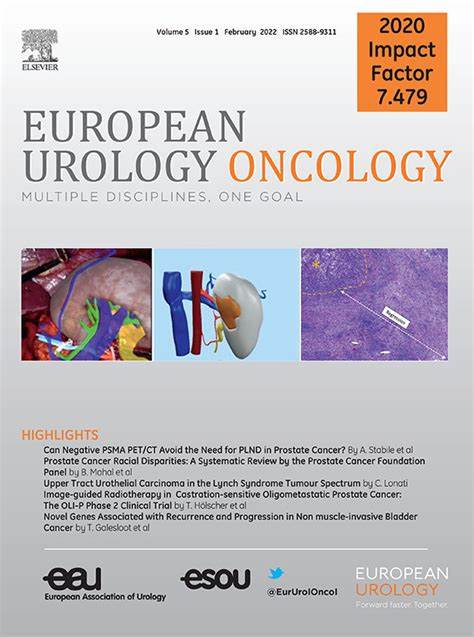与隐匿性寡转移钙化敏感性前列腺癌的进展方式和失败模式相关的基因组决定因素
IF 8.3
1区 医学
Q1 ONCOLOGY
引用次数: 0
摘要
背景和目的:低转移性阉割敏感性前列腺癌(omCSPC)是转移性疾病进展的早期状态,与疾病负担较重的患者相比,患者的预后较好。尽管前列腺癌一般较为隐匿,但仍存在很大的异质性,一些患者的临床病程更具侵袭性,而临床特征本身无法解释其原因。我们的目的是研究肿瘤基因组学与omCSPC首次治疗(转移导向和/或全身治疗)后的进展模式(MOP)和失败模式(POF)的相关性:我们开展了一项国际多机构回顾性研究,研究对象是接受过转移性omCSPC治疗的男性患者,他们在首次治疗后至少随访1年,并接受了肿瘤新一代测序。报告了相关通路基因组改变的描述性澳门巴黎人娱乐官网和 POF 结果。MOP定义为I级,长期控制(LTC;最后一次随访时无放射学进展);II级,少进展(1-3个病灶);或III级,多进展(≥4个病灶)。POF包括首次失败时病变的位置。受关注的基因组通路包括 TP53、ATM、RB1、BRCA1/2、SPOP 和 WNT(APC、CTNNB1、RNF43)。使用χ2检验比较了基因组与MOP/POF的相关性。探索性分析表明,COSMIC突变特征和差异基因表达也与MOP/POF相关。总生存期(OS)采用卡普兰-梅耶法计算,从首次失败时算起:我们在分析中纳入了267名患者;大多数患者在少转移灶有一个(47%)或两个(30%)转移病灶。3年的OS率与MOP显著相关(多发转移为71%,少发转移为91%;P = 0.005)。TP53突变与明显较低的长期生存率相关(27.6% vs 42.3%; p = 0.04),RB1突变与较高的多发性进展率相关(50% vs 19.9%; p = 0.022)。关于POF,骨衰竭在TP53突变的肿瘤中更常见(44.8% vs 25.9%;p = 0.005),而在SPOP突变的肿瘤中较少见(7.1% vs 31.4%;p = 0.007)。内脏衰竭在WNT通路突变(17.2% vs 6.8%,p = 0.05)或SPOP突变(17.9% vs 6.3%;p = 0.04)的肿瘤中更为常见。最后,内脏和骨骼衰竭与不同的基因表达谱有关:结论和临床意义:肿瘤基因组学提供了治疗远期omCSPC后MOP和POF的新见解。TP53和RB1基因突变的患者病情进展的可能性更高,TP53、SPOP和WNT通路突变可能在转移性有机体中发挥作用。患者摘要:我们评估了转移性前列腺癌首次治疗后的癌症进展情况,转移灶多达5个。我们发现,某些基因的突变与这些患者进一步转移的位置和程度有关。本文章由计算机程序翻译,如有差异,请以英文原文为准。
Genomic Determinants Associated with Modes of Progression and Patterns of Failure in Metachronous Oligometastatic Castration-sensitive Prostate Cancer
Background and objective
Oligometastatic castration-sensitive prostate cancer (omCSPC) represents an early state in the progression of metastatic disease for which patients experience better outcomes in comparison to those with higher disease burden. Despite the generally more indolent nature, there is still much heterogeneity, with some patients experiencing a more aggressive clinical course unexplained by clinical features alone. Our aim was to investigate correlation of tumor genomics with the mode of progression (MOP) and pattern of failure (POF) following first treatment (metastasis-directed and/or systemic therapy) for omCSPC.
Methods
We performed an international multi-institutional retrospective study of men treated for metachronous omCSPC who underwent tumor next-generation sequencing with at least 1 yr of follow-up after their first treatment. Descriptive MOP and POF results are reported with respect to the presence of genomic alterations in pathways of interest. MOP was defined as class I, long-term control (LTC; no radiographic progression at last follow-up), class II, oligoprogression (1–3 lesions), or class III, polyprogression (≥4 lesions). POF included the location of lesions at first failure. Genomic pathways of interest included TP53, ATM, RB1, BRCA1/2, SPOP, and WNT (APC, CTNNB1, RNF43). Genomic associations with MOP/POF were compared using χ2 tests. Exploratory analyses revealed that the COSMIC mutational signature and differential gene expression were also correlated with MOP/POF. Overall survival (OS) was calculated via the Kaplan-Meier method from the time of first failure.
Key findings and clinical implications
We included 267 patients in our analysis; the majority had either one (47%) or two (30%) metastatic lesions at oligometastasis. The 3-yr OS rate was significantly associated with MOP (71% for polyprogression vs 91% for oligoprogression; p = 0.005). TP53 mutation was associated with a significantly lower LTC rate (27.6% vs 42.3%; p = 0.04) and RB1 mutation was associated with a high rate of polyprogression (50% vs 19.9%; p = 0.022). Regarding POF, bone failure was significantly more common with tumors harboring TP53 mutations (44.8% vs25.9%; p = 0.005) and less common with SPOP mutations (7.1% vs 31.4%; p = 0.007). Visceral failure was more common with tumors harboring either WNT pathway mutations (17.2% vs 6.8%, p = 0.05) or SPOP mutations (17.9% vs 6.3%; p = 0.04). Finally, visceral and bone failures were associated with distinct gene-expression profiles.
Conclusions and clinical implications
Tumor genomics provides novel insight into MOP and POF following treatment for metachronous omCSPC. Patients with TP53 and RB1 mutations have a higher likelihood of progression, and TP53, SPOP, and WNT pathway mutations may have a role in metastatic organotropism.
Patient summary
We evaluated cancer progression after a first treatment for metastatic prostate cancer with up to five metastases. We found that mutations in certain genes were associated with the location and extent of further metastasis in these patients.
求助全文
通过发布文献求助,成功后即可免费获取论文全文。
去求助
来源期刊

European urology oncology
Multiple-
CiteScore
15.50
自引率
2.40%
发文量
128
审稿时长
20 days
期刊介绍:
Journal Name: European Urology Oncology
Affiliation: Official Journal of the European Association of Urology
Focus:
First official publication of the EAU fully devoted to the study of genitourinary malignancies
Aims to deliver high-quality research
Content:
Includes original articles, opinion piece editorials, and invited reviews
Covers clinical, basic, and translational research
Publication Frequency: Six times a year in electronic format
 求助内容:
求助内容: 应助结果提醒方式:
应助结果提醒方式:


